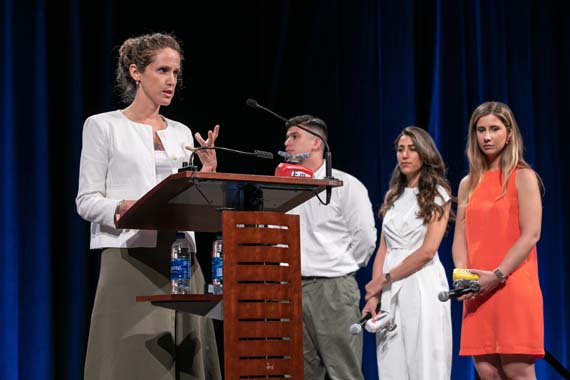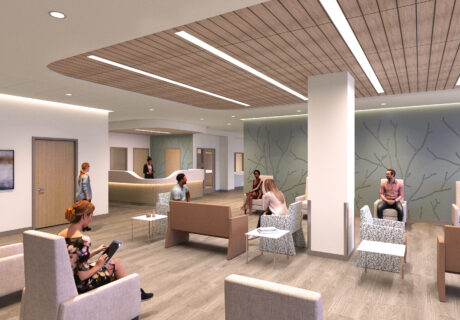Breaking Through Winner: Team Q+A
The winner of Healthcare Design’s conceptual design competition, Breaking Through, was a team from HDR, which presented its MASH (mobile acute services hospital) concept on-stage during the 2018 Healthcare Design Expo & Conference. The concept is an independent pod-based system of drones that can be assembled anywhere without relying on existing infrastructure or a site, allowing a quick response to the sites of conflicts or natural disasters.
Healthcare Design talked to the team, which included Romina Triboli Pisi, design leader; Margot Cougal, architectural coordinator; Mira Ebaf, architectural coordinator; and Ben Belson, architectural coordinator, about the concept and how it was developed.
Find the interview below, and read more about MASH here.
Healthcare Design: What inspired you to take part in the Breaking Through conceptual design competition?
Margot Cougal: As part of the health sector, it was a great opportunity for us to push the boundaries and free ourselves from the usual constraints that we face in other projects. As architects we accepted and embraced the challenge because we truly believe that the marriage of architecture and technology can help to improve healthcare design in the future.
How did you form your team? Did you have a strategy in recruiting participants?
Ben Belson: HDR was looking for young and dynamic participants who were willing to work on this project on their own time. Everyone on the team comes from a different background and holds unique experiences as designers in various fields. We were willing to be challenged. We are all passionate about healthcare, and this is what inspired us to take part in the design competition. This was a leading opportunity for us to explore our knowledge and have fun in developing a concept about healthcare in the future.
What future challenge in delivering healthcare did you choose to address with your conceptual design and why?
Romina Triboli Pisi: The fact that humans have always found themselves helpless in the face of disasters is the reason we chose this problem. A catastrophe will always happen, and our idea was to design a hospital that will not only adapt to people’s needs, but also to changes in the environment.
This was a long process that’s spanned about a year. How did you approach the development and refinement of your concept from first ideation to now?
Mira Ebaf: We started looking for an idea, a concept … a concept that speaks to the future, while analyzing what healthcare challenge we wanted to address. Then we asked the question of how can we turn this idea into a physical model. Guided by thorough research, which had a pivotal role in shaping this physical model and, of course, our supervisor’s advice, we managed to model this idea to turn it into a three-dimensional object. And I believe that because we are all from different parts of the world, with different ideas, sets of skills, and perspectives, those points of view helped develop the concept. We truly shared the same sense of value, which glued the whole project together.
What traditional project limitations (cost, schedule, codes, etc.) wouldn’t have allowed this concept to be a reality today?
Ebaf: Having an unconventional project where the simple rules of architecture, such as location and fixed static buildings, are not applied resulted in unconventional limitations, some of which might be political limitations, questioning who’s going to control the MASH, air traffic management policies and technology hurdles to overcome, the cost of building this flying hospital, and not to forget the psychological barriers–the idea of flying a pilot-less pod, and being treated remotely are all necessary factors to consider.
How might this idea inspire future design solutions, even within the traditional confines of healthcare design?
Belson: When our team came together to design MASH, we wanted to reimagine the potential of an emergency hospital. Traditional healthcare has always been rooted in solidarity and restrictions, which can be difficult when dealing with ever-changing emergency situations. We came up with a strong concept where technology and architecture, combined together, can make a significant change in the future of healthcare design. The team decided MASH was to break away from traditional norm and build a design that is based on efficiency, quick emergency response, flexibility, mobility, and best technologies in order to reduce the number of casualties in catastrophes.
MASH is not the end of our innovation but a catalyst to converse with the concept of future healthcare services. As architects we believe it is important to constantly push the boundaries, think about new solutions to improve all aspects of healthcare, help save more lives, and provide better spaces for patients to be treated and staff to work within.
What do you find most innovative about your concept?
Triboli Pisi: In our opinion, the most innovative aspect of our concept is that it defies the standards of architecture in general and healthcare design in particular. We designed a hospital that responds to people in need and flies to them. In addition, we embedded technologies like pilot-less cars, drones, remote-controlled entities and robotics in our design to direct the future of healthcare.
Do you think innovation exists in healthcare design? How can we as an industry better encourage it?
Cougal: Yes, innovation exists. It is necessary as designers to simply BE better—to provide better outcomes and solutions. The way we deliver is constantly changing, we are more specialized these days, more acute.
What will you do with the $10,000?
Cougal: Invest part of the money in research, mainly on how to enhance technologies and utilize them in healthcare design, and donate the other part to non-governmental organizations to improve emergency disaster deployment.



